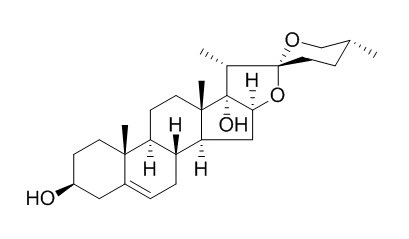Pennogenin
Pennogenin steroidal saponins could be utilized to develop anticancer medicines.
Inquire / Order:
manager@chemfaces.com
Technical Inquiries:
service@chemfaces.com
Tel:
+86-27-84237783
Fax:
+86-27-84254680
Address:
1 Building, No. 83, CheCheng Rd., Wuhan Economic and Technological Development Zone, Wuhan, Hubei 430056, PRC
Providing storage is as stated on the product vial and the vial is kept tightly sealed, the product can be stored for up to
24 months(2-8C).
Wherever possible, you should prepare and use solutions on the same day. However, if you need to make up stock solutions in advance, we recommend that you store the solution as aliquots in tightly sealed vials at -20C. Generally, these will be useable for up to two weeks. Before use, and prior to opening the vial we recommend that you allow your product to equilibrate to room temperature for at least 1 hour.
Need more advice on solubility, usage and handling? Please email to: service@chemfaces.com
The packaging of the product may have turned upside down during transportation, resulting in the natural compounds adhering to the neck or cap of the vial. take the vial out of its packaging and gently shake to let the compounds fall to the bottom of the vial. for liquid products, centrifuge at 200-500 RPM to gather the liquid at the bottom of the vial. try to avoid loss or contamination during handling.
Molecules.2019, 24(21):E3834
Molecules2022, 27(14):4601
Biomed Pharmacother.2019, 111:262-269
Int Immunopharmacol.2019, 71:22-31
Molecules.2024, 29(5):1050.
Phytomedicine2022, 104:154318
RSC Adv.2018, 32621-32636
Prev Nutr Food Sci.2024, 29(4):466-473.
American Association for Anatomy2020, doi: 10.1002.
Applied Biological Chemistry2022, 65(85).
Related and Featured Products
Iran J Pharm Res. 2011 Spring;10(2):279-86.
In-vitro Antitumor Activity and Antifungal Activity of Pennogenin Steroidal Saponins from paris Polyphylla var. yunnanensis.[Pubmed:
24250355]
Paris polyphylla Smith var. yunnanensis, has been used in traditional Chinese medicine for its antibiotic and anti-inflammatory properties; in addition it has been used to cure liver cancer in particular.
METHODS AND RESULTS:
In this current study, β-ecdysterone (1) and three Pennogenin steroidal saponins (2-4) were isolated from the EtOH extract of Paris polyphylla var. yunnanensis, and then tested for their antitumor and antifungal activities. Spectroscopic data was used to confirm their structures. Their antitumor properties were determined by using an MTT assay in addition to ethidium bromide and acridine orange staining techniques. Compounds 2, 3 and 4 exhibited significant anti-proliferation activities against HepG2 cells, with IC50 values of 13.5 μM, 9.7 μM and 11.6 μM respectively, obtained following 48 h treatment. Furthermore, we found these Pennogenin steroidal saponins could induce HepG2 cells apoptosis at a concentration of 20 μM after 48 h treatment. Compounds 2, 3 and 4 were confirmed to exhibit moderate antifungal activity. The minimum inhibitory concentration (MIC) of compounds 2, 3 and 4 against saccharomyces cerevisiae hansen were 2.5 mg.mL(-1), 0.6 mg.mL(-1) and 0.6 mg.mL(-1), respectively. The MIC of compounds 2, 3 and 4 against Candida albicans were 1.2 mgmL(-1), 0.6 mg.mL(-1) and 1.2 mg.mL(-1), respectively. The analysis of the bioactivity-structure relationship shows that the sugar moiety plays a critical role in the activity of steroid moiety.
CONCLUSIONS:
Our results suggest that these three Pennogenin steroidal saponins could be utilized to develop anticancer medicines.
Molecules . 2016 Aug 20;21(8):1095.
Beneficial Effects of Trillium govanianum Rhizomes in Pain and Inflammation[Pubmed:
27556434]
Abstract
Trillium govanianum rhizome is used as an analgesic and anti-inflammatory remedy in traditional medicine in northern Pakistan. In an attempt to establish its medicinal value, the present research evaluated the analgesic and anti-inflammatory potential of T. govanianum. The in vivo anti-inflammatory activity of extract and fractions was investigated in the carrageenan induced paw edema assay. The in vitro suppression of oxidative burst of extract, fractions and isolated compounds was assessed through luminol-enhanced chemiluminescence assay. The in vivo analgesic activity was assayed in chemical and thermal induced nociceptive pain models. The crude methanol extract and its solvent fractions showed anti-inflammatory and analgesic responses, exhibited by significant amelioration of paw edema and relieve of the tonic visceral chemical and acute phasic thermal nociception. In the oxidative burst assay, based on IC50, the crude methanol extract and n-butanol soluble fraction produced a significant inhibition, followed by chloroform and hexane soluble fractions as compared to ibuprofen. Similarly, the isolated compounds Pennogenin and borassoside E exhibited significant level of oxidative burst suppressive activity. The in vivo anti-inflammatory and analgesic activities as well as the in vitro inhibition of oxidative burst validated the traditional use of T. govanianum rhizomes as a phytotherapeutic remedy for both inflammatory conditions and pain. The observed activities might be attributed to the presence of steroids and steroid-based compounds. Therefore, the rhizomes of this plant species could serve as potential novel source of compounds effective for alleviating pain and inflammation.
Keywords: Trilliaceae; analgesic; anti-inflammatory; borassoside E; oxidative burst; Pennogenin.



